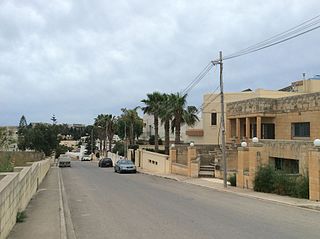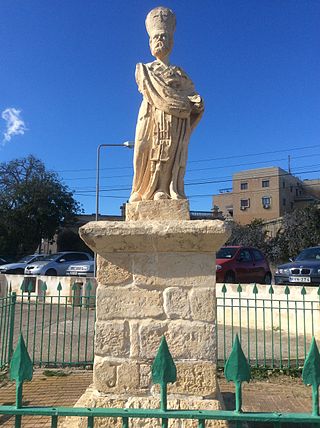
Iklin is a village in the Central Region of Malta, with a population of 3,247 as at 2021. Iklin was established in the mid-20th century; however some archaeological sites and a medieval chapel, named as St. Michael Chapel, are proof to earlier settlements. Until recently, the town was considered to form part of the Three villages of Malta, as part of Lija. With the separation of Iklin from Lija, Iklin is no longer part of the three villages. It is bordered by Għargħur, San Ġwann, Birkirkara, Balzan and Naxxar.

Guspini is a town and comune of about 12,000 inhabitants in west Sardinia (Italy), in the province of South Sardinia. It is 62 kilometres (39 mi) from the capital Cagliari and 14.6 kilometres (9.1 mi) from the railway station at San Gavino Monreale.

Burmarrad is a hamlet in St. Paul's Bay, Malta. The main heritage site is the San Pawl Milqi zone, where there is a chapel dedicated to St. Paul, built on the remains of a Roman temple dedicated to Apollo, and tradition says to be the remains of the home of St. Publius.

Antonio Annetto Caruana, also known as A. A. Caruana, was a Maltese archaeologist and author.

The Lamta Archaeological Museum is an archaeological museum located in Lamta, Tunisia.

St. Paul's Catacombs are some of the most prominent features of Malta's early Christianity archeology. The archeological clearing of the site has revealed an extensive system of underground galleries and tombs dating from the third to the eighth centuries CE.

Tas-Silġ is a rounded hilltop on the south-east coast of the island of Malta, overlooking Marsaxlokk Bay, and close to the town of Żejtun. Tas-Silġ is a major multi-period sanctuary site with archaeological remains covering four thousand years, from the neolithic to the ninth century AD. The site includes a megalithic temple complex dating from the early third millennium BC, to a Phoenician and Punic sanctuary dedicated to the goddess Astarte. During the Roman era, the site became an international religious complex dedicated to the goddess Juno, helped by its location along major maritime trading routes, with the site being mentioned by first-century BC orator Cicero.

Borġ in-Nadur is an archaeological site located in open fields overlooking St George's Bay, near Birżebbuġa, Malta. It is occupied by a Tarxien phase megalithic temple as well as the remains of a Bronze Age village which includes the earliest fortification in Malta. The site is located close to various Bronze Age cart ruts and silos, a Roman villa at Ta' Kaċċatura, as well as Saint George Redoubt which was built thousands of years later in 1715–1716.

The Żejtun Roman villa is an archaeological complex in the city of Żejtun, in south-eastern Malta. The open-air remains contain areas of original Roman tiling and coloured stucco. The complex was an active settlement since the Bronze Age, although the presently visible remains can be mainly dated from the Punic period right up to Late Antiquity. The site was discovered in 1961, with the complex being the subject of two large-scale archaeological investigations, the first of which was carried out in the 1970s.

Ta' Ċieda Tower, also known as San Ġwann Roman Tower, is a Punic-Roman tower in San Ġwann, Malta. The exact origins of the tower could date back to pre-history with different architecture. It is argued that the tower could be of Punic origins rather than Roman but the latter have adapted it. The site of the tower was used as a cemetery, or more, during the Muslim caliphate in the medieval times. Following the expulsion of the Muslims in Malta a church dedicated to St. Helen was built on the site.

The remains of six Punic-Roman towers have been identified in Malta. They are believed to have been built while the island was part of the Punic or Roman Empires. Their architecture suggests a late Punic origin, and they remained in use throughout the Roman period, until at least the 3rd century AD. Evidence suggest that the towers were used to defend the island. The towers are clearly all built on high grounds, in specific locations, and could considerably communicate with signals from one to another. Similar towers are also found in nearby Tunisia with the same defensive system. In the context of time some locals still lived in caves with few others living in vernacular housing with similar characteristics to nearby Sicily.

Melite or Melita was an ancient city located on the site of present-day Mdina and Rabat, Malta. It started out as a Bronze Age settlement, which developed into a city called Maleth under the Phoenicians, and became the administrative centre of the island. The city fell to the Roman Republic in 218 BC, and it remained part of the Roman and later the Byzantine Empire until 870 AD, when it was captured and destroyed by the Aghlabids. The city was then rebuilt and renamed Medina, giving rise to the present name Mdina. It remained Malta's capital city until 1530.

The Temple of Proserpina or Temple of Proserpine was a Roman temple in Mtarfa, Malta, an area which was originally a suburb outside the walls of Melite. It was dedicated to Proserpina, goddess of the underworld and renewal.
The Temple of Apollo was a Roman temple in the city of Melite, in modern Mdina, Malta. It was dedicated to Apollo, the god of the sun and music. The temple was built in the 2nd century AD, and it overlooked a semi-circular theatre. The temple's ruins were discovered in the 18th century, and many architectural fragments were dispersed among private collections or reworked into new sculptures. Parts of the temple's crepidoma still exist, having been rediscovered in 2002.
Mario Buhagiar is an author, a Fellow of the Society of Antiquaries of London (FSA) and member of the National Order of Merit (MOM). He is professor in history of art at the University of Malta and was for 25 years head of the History of Art Department, which he founded.

Ta' Kaċċatura is an archaeological complex in the outskirts of Birżebbuġa, in southern Malta. The complex includes a rustic Roman villa and a number of underground cisterns. The rustic villa confirms the presence of a thriving olive oil industry in this part of the Maltese islands.

The Għar Għerduf catacombs at Ta' Kerċem, also known as Għar Gerduf, are the only surviving early Christian catacombs or paleochristian hypogea in Gozo, Malta. Għar Għerduf is a unique Roman burial site in Gozo, which has for centuries attracted the attention of scholars interested in Maltese archaeology. The site was visited by erudite visitors who often included a description of the place as they did for Ġgantija and the Xagħra Stone Circle.

The Gozo stele is a Phoenician language inscription found near Gozo, Malta in 1855. It is currently in the Gozo Museum of Archaeology.
The Ħal Resqun catacombs at Gudja, are interpreted as early Christian catacombs or paleochristian hypogea in Malta. The Ħal Resqun catacombs are especially notable for their carved decorations, and other features which are uncommon in Maltese catacombs, and of exceptional value. Some historians have suggested that, unlike other catacombs, those at Ħal Resqun portray enough Christian markers to be classified as paleochristian remains, while others view these features to be inconclusive. Some of the graffiti, interpreted by a number of historians as portraying a biblical scene, are thought to be unique in the world, and considered one of the most important remains from Late Antiquity in Malta.

The remains of an unidentified Punic building exist incorporated into several properties in Żurrieq, Malta. They include a well-preserved structure commonly known as the Punic Tower or the Żurrieq Tower which is found inside the private garden of the Domus Curialis, the house of the town's archpriest, and which is the most substantial surviving example of Punic architecture on the island.




















